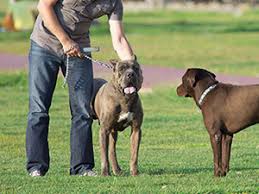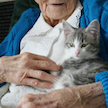Enrichment In The Home During Winter
Dr. E'Lise Christensen, Fear Free Board-Certified Veterinary Behaviorist
 Cold weather usually means the kids and pets spend more time indoors and they can go bonkers. Less exercise and activity could result in unwanted behavior issues. Dr. E'Lise Christensen is a board certified veterinary behaviorist. She'll share some great ideas for keeping your pets occupied and out of trouble. As far as the kids go, you're on your own. This is part of the Fear Free Expert Series.
Cold weather usually means the kids and pets spend more time indoors and they can go bonkers. Less exercise and activity could result in unwanted behavior issues. Dr. E'Lise Christensen is a board certified veterinary behaviorist. She'll share some great ideas for keeping your pets occupied and out of trouble. As far as the kids go, you're on your own. This is part of the Fear Free Expert Series.
Dr. Christensen explains that enrichment is really important, because when we look at our domestic animals that live in our homes, the reality is that even though they may have been domesticated for thousands of years, they still have very basic needs that many of us don't actually meet on a daily basis. We kind of assume that because our life is busy and we are doing many things that we choose to do, that our animals are also being mentally challenged and getting to choose to participate in specific activities. But the reality is that animals that feel like there isn't that much to do, may either start doing a lot of stuff that you don't want them to do because it's interesting for them, or they may actually shut down and do nothing.
So does this mean that Dr. Christensen sees more behavior problems in the winter time because people are less likely to get out with their animals? She explains that the difference here would be unruly behaviors versus true behavioral disorders. Unruly behaviors are normal behaviors that are species specific that people don't like. So for instance, jumping up on people to lick their faces is a very normal behavior of dogs. That is part of their suite of behaviors that comes with them genetically and one of the things that we alternately punish and alternately reinforce, sometimes within five seconds. So that is a behavior. Those types of behaviors are ones that are particularly vulnerable to getting worse when enrichment is low, because all these normal behaviors have nowhere to go. So the dogs and cats find new places to utilize these behaviors and usually they do things that people don't like. As a result, when people are not actively getting their animals out to explore the world or providing enrichment and play opportunities that are variable, you can definitely see these unruly behaviors escalate.
 To enrich your pet's life, you can go out and buy toys and puzzles, which Dr. Christensen encourages you to do to play with your pet. But the great thing is that there are so many other ways you can enrich your animal's life. Even things as simple, although some people might find this gross, as picking up something off the street that's new and interesting and bringing it in and allowing your animal to sniff it. This works especially for dogs, because they're very olfactory in nature. That is their major sense, because the way they see the world is through their nose. So if you bring in some things that are new and interesting to them, you've just opened up a book for them, literally. You can also give them an opportunity to binge on a TV show. Another thing is to give them things like toilet paper rolls and paper towel rolls, as well as boxes, to play with. Of course, if you have a pet that might swallow cardboard, you wouldn't do that. However, letting your dog rip open a box and solving a puzzle can be a really great way to enrich your pet - and it's free.
To enrich your pet's life, you can go out and buy toys and puzzles, which Dr. Christensen encourages you to do to play with your pet. But the great thing is that there are so many other ways you can enrich your animal's life. Even things as simple, although some people might find this gross, as picking up something off the street that's new and interesting and bringing it in and allowing your animal to sniff it. This works especially for dogs, because they're very olfactory in nature. That is their major sense, because the way they see the world is through their nose. So if you bring in some things that are new and interesting to them, you've just opened up a book for them, literally. You can also give them an opportunity to binge on a TV show. Another thing is to give them things like toilet paper rolls and paper towel rolls, as well as boxes, to play with. Of course, if you have a pet that might swallow cardboard, you wouldn't do that. However, letting your dog rip open a box and solving a puzzle can be a really great way to enrich your pet - and it's free.
Dr. Christensen explains that even though it might be snowing, or it has snowed, there are still ways to provide enrichment outside. One way is to sprinkle some of their kibble around in the snow and let them look for it. You could even feed them their whole meal that way. This is really the true enrichment, because dogs would normally be searching for their food and spend a fair amount of time per day doing so. So anything you can do to help them spend more time looking for their food, is sort of like you walking an extra 15 minutes for the best bakery, versus just going around the corner for a crappy one.
So what does the expert do for her own dog during the winter to enrich their life? Unfortunately, Dr. Christensen's elderly dog passed away. But enrichment for her, because she was a small elderly dog with cognitive dysfunction, was very gentle. What you can do in the case of these older dogs or cats is to provide them enrichment at the level that they're able to do it. So for instance, if you are an older person and at age 73 you used to love doing the New York Times crossword puzzle, but now maybe you're 89 and it's just a little too much. So maybe we backtrack to something a little bit easier, where the reinforcement rate is higher, so you can answer those word puzzles very quickly. Same thing goes for our dogs and cats.
 When you have older animals, you may give them something like a snuffle mat, which is a very soft kind of rug that's specifically made for animals for foraging behavior. You just sprinkle the kibble, or whatever treats you might be using, in there. You then ruffle it up so that they fall down in between the pile of fabric pieces. To get the food, your animal has to nose around, just like they would if they were a dog visiting a garbage dump. This is where dogs mostly hang out if they're lucky enough to be close to some high intensity resource like that, and they would be shuffling around in there all day. We can now emulate that essentially by providing a snuffle mat, because nobody wants a garbage dump in their house.
When you have older animals, you may give them something like a snuffle mat, which is a very soft kind of rug that's specifically made for animals for foraging behavior. You just sprinkle the kibble, or whatever treats you might be using, in there. You then ruffle it up so that they fall down in between the pile of fabric pieces. To get the food, your animal has to nose around, just like they would if they were a dog visiting a garbage dump. This is where dogs mostly hang out if they're lucky enough to be close to some high intensity resource like that, and they would be shuffling around in there all day. We can now emulate that essentially by providing a snuffle mat, because nobody wants a garbage dump in their house.
There are all fabulous ideas, and for those of you that are just sitting down and looking at your dog in the corner who wants to do something, go out and enrich their lives.
You can find more great tips for enriching your pet's life over at Fear Free Happy Homes and Fear Free Pets.
Listen and Explore the Fear Free Expert Series
What To Do When Encountering Off-Leash Dogs
Stephanie, Colman, Guide Dogs of America
 It's the stuff of nightmares. You and your dog are enjoying a walk through the neighborhood when, all of a sudden, you spot an unaccompanied canine heading your way. It could turn into a bad scene even if your dog is socialized. Stephanie Colman, the manager of the "Puppy Department" at Guide Dogs of America, has the five things you need to do if you encounter an off-leash or stray dog.
It's the stuff of nightmares. You and your dog are enjoying a walk through the neighborhood when, all of a sudden, you spot an unaccompanied canine heading your way. It could turn into a bad scene even if your dog is socialized. Stephanie Colman, the manager of the "Puppy Department" at Guide Dogs of America, has the five things you need to do if you encounter an off-leash or stray dog.
Stephanie has been a professional dog trainer for many years and deals with a lot of behavior issues and tells us a little bit about how to deal with a dog that is off leash that's approaching you or approaching you and your dog. This can be a scary situation, especially if the dog appears to be aggressive.
When Stephanie is out with her own dogs, particularly if she's someplace and has her dogs on leash, just seeing a lose dog coming toward them, whether it's with a person or just a loose dog sort of roaming at large, it always gives her pause for concern. You just don't know necessarily if the dog is coming up to be friendly or coming up to start problems. The other issue is that it's not always about the other dog. Sometimes you're with dogs who don't appreciate dogs they don't know coming up and invading their personal safety bubble. It can be a tough , and if you have a dog that you know is uncomfortable with that, it's very difficult to not panic a little bit, which of course you know always makes it worse.
The first thing Stephanie tends to suggest for people is whenever you're out with your dog, whether your dog is friendly, whether your dog's working through some challenges, whatever the case may be, take advantage of that time and pay attention to your dog. And it's tough, because we always have cell phones and you see so many people out with their dog, but they're really just paying more attention to their phones.
So being proactive and being aware of your surroundings is probably the best piece of advice Stephanie can give people, because then you can maybe spot potential trouble up ahead and you're less likely to feel like you're suddenly being ambushed.
However, sometimes you are ambushed when an animal suddenly appears from behind a car or out of the bushes. And at the end of the day, we're all only human and when something literally jumps out and catches us off guard like that, we are probably going to react unfavorably with some sort of a scream or some sort of startle.
 Stephanie likes to raise her own dogs to believe that when they're out together, it's her job to keep the pack safe. She doesn't necessarily want her dogs to feel like they have to carry that burden on their shoulders. So if she has some sort of maybe less than perfect reaction where she says, "Oh my gosh," or she screams, the first thing she'll do in this situation is to give her dogs a treat so they won't all panic. She doesn't want her dogs to necessarily go, "Well it must be really bad. Listen to her, she's freaking out." So she always try to reinforce her dogs just for remaining calm or not joining in, if she's having a more reactive moment because something caught her off guard.
Stephanie likes to raise her own dogs to believe that when they're out together, it's her job to keep the pack safe. She doesn't necessarily want her dogs to feel like they have to carry that burden on their shoulders. So if she has some sort of maybe less than perfect reaction where she says, "Oh my gosh," or she screams, the first thing she'll do in this situation is to give her dogs a treat so they won't all panic. She doesn't want her dogs to necessarily go, "Well it must be really bad. Listen to her, she's freaking out." So she always try to reinforce her dogs just for remaining calm or not joining in, if she's having a more reactive moment because something caught her off guard.
So should you put yourself in between your dogs and an approaching dog? Of course avoiding confrontation is always your best bet. So if Stephanie sees a dog up ahead, she'll turn around and walk the opposite way. If a dog keeps approaching and she's trapped and doesn't have a great escape exit at that moment, she will absolutely put herself between her dog and the unknown dog. She will also yell at the unknown dog, saying things like. "Get get back" and "Go on." If she has treats with her, she'll try tossing a hand handful of treats to the unknown dog, which will often get them to stop coming up in your space while they stop and sort of go, "Oh cookies." Then while they are distracted snorting up Scooby Snacks, that gives you your few seconds to turn and bail.
Stephanie also carries some sort of deterrent spray, like citronella in a can. It's not harmful to the dogs that are rapidly approaching and about to invade your space, but it's unpleasant enough that it will back most dogs off.
Another thing that she's used it for very effectively, is to let the owners of the off leash dogs know that she really doesn't want their dog to come up in her face. You'll often see the dogs off leash and then behind them you have the owner holding the leash with no dog on it saying, "Oh it's okay, he's friendly." That's great that the dog is friendly, but sometimes you're with a dog who maybe isn't friendly and doesn't want that unknown dog coming up in his space. Stephanie has often been in the uncomfortable position of having to say, "Right, I know, but could you just call your dog." They then may say again, "No, no really he's friendly." And if she's asked a couple of times and not getting the response she need, she holds out her can. Then states again, "No really, please call your dog." That usually lets people know that she's serious and that they really need to call their dog.
This might not make her friends on her walks, but it is her responsibility to keep her dogs safe and to not let them get into a situation where maybe she needs to react unfavorably, because somebody else has let their dog get into her dogs' personal space. She will sometime even explain to these people that she's sorry, but her dogs don't like dogs that they don't know coming into their face. And also, that it's just citronella and it's not going to harm their dog.
Stephanie explains that some of the more creative things some of her clients have done is if they have a tiny dog is to pick them up and put them in a nearby trashcan and close the lid. Another thing is to put the smaller dogs in the back of a pickup truck if one is nearby.
 If you've had some sort of ambush, Stephanie explains, and it's been a little bit traumatizing for you or for your dog, it's important to try to make sure that the next time you're out and you see a dog, you don't initially tense. All of that tension goes right down the leash, which can cause your dog to be concerned even before anything happens. This is super hard, because if you've had a scary encounter on a walk and you see a dog, you're anticipating that it could go bad again. So always trying to remain calm. It's super important to not choke up on your leash, because we have a tendency of tightening up on that leash and drawing our dog into it as close and as tight as possible. But that tight leash really is almost saying to your dog that there is danger. So trying to maintain that loose leash is super important.
If you've had some sort of ambush, Stephanie explains, and it's been a little bit traumatizing for you or for your dog, it's important to try to make sure that the next time you're out and you see a dog, you don't initially tense. All of that tension goes right down the leash, which can cause your dog to be concerned even before anything happens. This is super hard, because if you've had a scary encounter on a walk and you see a dog, you're anticipating that it could go bad again. So always trying to remain calm. It's super important to not choke up on your leash, because we have a tendency of tightening up on that leash and drawing our dog into it as close and as tight as possible. But that tight leash really is almost saying to your dog that there is danger. So trying to maintain that loose leash is super important.
Stephanie also works really hard to try to teach her dogs that in the presence of another dog, she will be more fun and will give her dogs treats. If you're able to do this consistently, and it does take some practice depending on how interested in other dogs your dog happens to be. So it can take a while. But when it's done effectively, then the presence of another dog almost becomes a cue for your dog to look to you and almost say, "I hear a dog, where's my cookie?" If she has a dog that tends to be a little bit reactive towards other dogs, she would rather put in the effort to teach that alternative behavior, than to have to strong-arm her dog because he's being so reactive every time he sees other dogs.
Whatever approach you choose, do your best to remain calm so as not to escalate the situation with your own panicked behavior. After any altercation with a loose dog, carefully assess your dog for injuries and consider taking him to the veterinarian, as bite wounds can be difficult to spot under thick fur. Write down as much as you can remember about the incident, such as location and a description of the dog, and contact your local animal control agency.
Visit Website
New Year's Resolution for Cat Owners - Don't Forget Kitty - Dr. Debbie
 While it doesn't seem right, cats are 30-percent less likely to receive veterinary care than dogs.
While it doesn't seem right, cats are 30-percent less likely to receive veterinary care than dogs.
For example, Patty cringes at the idea of taking Muffin, her 12-year-old Persian cat to the veterinarian. She envisions the ten minute wrangle to catch her, the acrobatics placing Muffin in the pet carrier, and the ear piercing protest on route to the hospital. Patty observes Muffin lounging contently on the couch, considers her cat's healthy appetite, trouble free litter box use, and indoor lifestyle. Patty puts the carrier away declaring, "Why would I want to go through the hassle taking her in to the vet when I can see she is perfectly healthy." But skipping that veterinary checkup could mean big trouble for Muffin though.
Senior cats over seven years old can develop diseases such as hyperthyroidism, hypertension, osteoarthritis, kidney disease and diabetes. And failing to detect these problems can lead to more advanced health problems, less treatment options, less favorable outcome and higher future veterinary costs down the road.
Why Are Cats Forgotten?
In the U.S., cats are the most popular household pet, with over 80 million pet cats nationwide. But despite the cat's status as top pet, they are 30-percent less likely to be taken to the veterinarian than their canine counterparts. So why don't cats receive the same veterinary care that dogs do?
There are many reasons why cat owners might not present the cat to the veterinarian. Cat owners may not see a health concern. Cats don't typically complain, especially with chronic developing diseases, so cat owners miss the boat if they expect kitty to tell them when they are sick. The self-sufficient feline nature makes it is more difficult for pet owners to detect abnormalities in appetite, elimination and behavior.
The economy is a common reason that some pet owners fail to get kitty in to the veterinary office. Some cat owners forgo preventative veterinary visits as a means to minimize costs, not realizing the long term health consequences. And like Muffin's owner, many cat owners' just don't want to stress the cat and chose to skip the vet travel and feline melodramatics.
 Some cat owners also don't value the veterinary examination or the health clues it provides. And preventative pet care for some owners consists solely by vaccinations, and when those aren't pursued, veterinary care falls by the wayside.
Some cat owners also don't value the veterinary examination or the health clues it provides. And preventative pet care for some owners consists solely by vaccinations, and when those aren't pursued, veterinary care falls by the wayside.
My Perspective
In my veterinary office, I've seen cat patients whose last veterinary exam was many years ago, perhaps two, three or even ten years ago. That's a long time for a cat's medical problems to brew and develop. Sometimes it's already too late and advanced disease has set in. I'd much rather see those cats years before when we can better help them, rather than at a euthanasia visit.
During a veterinary exam, the doctor performs a comprehensive examination to detect abnormalities. Maybe it's a new lump, a change in body condition, an altered stance, a tell-tale odor of kidney disease or a useful clue provided by the owner's health history. The veterinary examination is the best money you can invest in your cat's health and which generates teamwork between you and your vet to keep your pet healthy.
Resolutions for the Future
No wonder cats are the favored pet with their gorgeous looks, complex personalities and mysterious aura. Resolve to keep your kitty healthy in 2026 and ensure your cat gets to the veterinarian at least once a year, although twice a year is preferred for senior cats. When that next veterinary visit comes, be armed with confidence, patience and of course, a sturdy pet carrier.
Featured veterinarian known as "Dr. Debbie" on national pet radio program, Animal Radio. Ebook author of "Yorkshire Terriers: How to Be Your Dog's Best Friend"; "Pugs: How to Be Your Dog's Best Friend"; "Mini Schnauzers: How to Be Your Dog's Best Friend"; and "Shih Tzu: How to Be Your Dog's Best Friend." Dr. Debbie's books.
Visit Website
Animal Radio News - Lori Brooks
 Pet Food Sector Grows
Pet Food Sector Grows
Researchers say most of the growth in the pet food sector of the 72 billion dollar pet care industry is going to behemoths Amazon.com and Chewy.com. Four other trends they expect to influence the American pet food industry in the New Year are home-delivered pet food, whether customized like fresh foods or non-customized like bagged or canned food. Another trend is pet parents who are searching for foods with preventative benefits. This is very high quality pet food, which improve an animal's health and those that include nutraceutical ingredients such as probiotics, omega fatty acids, glucosamine, fruits and vegetables. There is also DIY (do-it-yourself) pet food. Pet parents often supplement pet's meals with additional homemade side dishes such as grilled meat, limited ingredient meals, home-cooked pumpkin or other favorite indulgences. Other pet owners may pursue a "semi-homemade" approach by enhancing the pet's meal with various additions such as mix-ins, toppers, sauces and even spray-on nutrients.
 Beatles Song For Dogs
Beatles Song For Dogs
Sir Paul McCartney confirmed that one of the all time best Beatles songs, 'A Day in the Life,' has a special sound included in the track that only your dog can hear. It has long been a rumor that dogs knew something about the song that humans didn't. McCartney finally let the truth be known saying that the Beatles did put a sound that only dogs could hear on the song. He said if you ever play the 'Sgt Pepper CD,' just watch your dog when the song 'A Day in the Life' comes on. Turns out the Beatles literally recorded a dog whistle in the song and thus was born a Beatles song for dogs. The whistle has a frequency of 15 kilohertz - one that goes undetected by the human ear.
Most Popular Cat Names
The top five male cats names in the US start at number five with Max, in fourth place is Charlie, third is Leo, second is Oliver and the most popular name for male cats in the US is Milo. For female cats, number five is Chloe, fourth is Lily, third is Lucy, second is Bella and the most popular name for female cats in the US is Luna. The most popular cat names in UK, are a little different. Starting at number five is Jasper, in fourth place is Leo, third is Milo, second is Oscar and the most popular name for male cats in the UK is Charlie. For female cats, number five is Daisy, fourth is Molly, third is Poppy, second is Bella and the most popular name for female cats in the UK is Luna.
Most Popular Dog Names
If you got a new pet this year or are considering adding another pet to your family in the New Year, here's the latest list of the most popular dog names. Starting at number five is Milo, in fourth place is Buddy, third is Cooper, second is Charlie and the most popular name for male dogs in the US is Max. For female dogs, number five is Willow, fourth is Lucy, third is Daisy, second is Bella and the most popular name for female dogs in the US once again is Luna.
 Do Pets Slow Down Your Aging Process?
Do Pets Slow Down Your Aging Process?
After all we've heard, there is a report in the British Medical Journal that said having a pet doesn't seem to slow down your aging process after all. This research showed that pet owners appeared to have the same physical and psychological health levels as non-pet owners. Experts at University College London (UCL) and Cambridge University conducted the study. The researchers analyzed figures from more than 8,700 adults with an average age of sixty-seven. A third of participants owned a pet, with 18-percent owning a dog, 12 -percent a cat and 3-percent another animal. After taking into account a range of relevant variables such as smoking and drinking, the researchers found no evidence of a strong association of any type of pet ownership with things like walking speed, lung function, grip strength, leg raises, balance, blood inflammatory markers, memory or depression. They said these results held true after separate studies were done of male and female pet owners. But they point out that it was an observational study, so no firm conclusions can be drawn about the cause and effect.
 Listen to the entire Podcast of this show (#1360)
Listen to the entire Podcast of this show (#1360)





